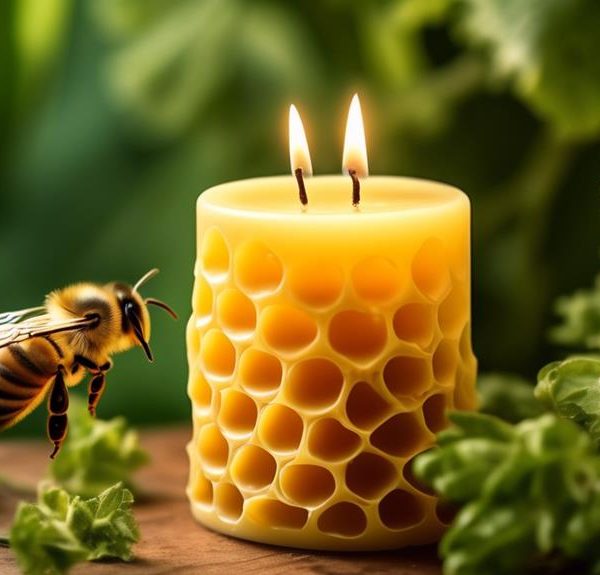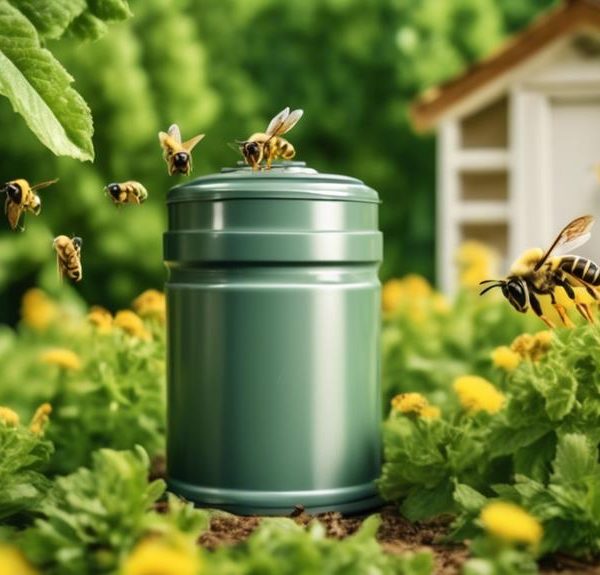Discover the surprising reasons bees are invading your home and learn effective ways to prevent this buzzing nuisance.
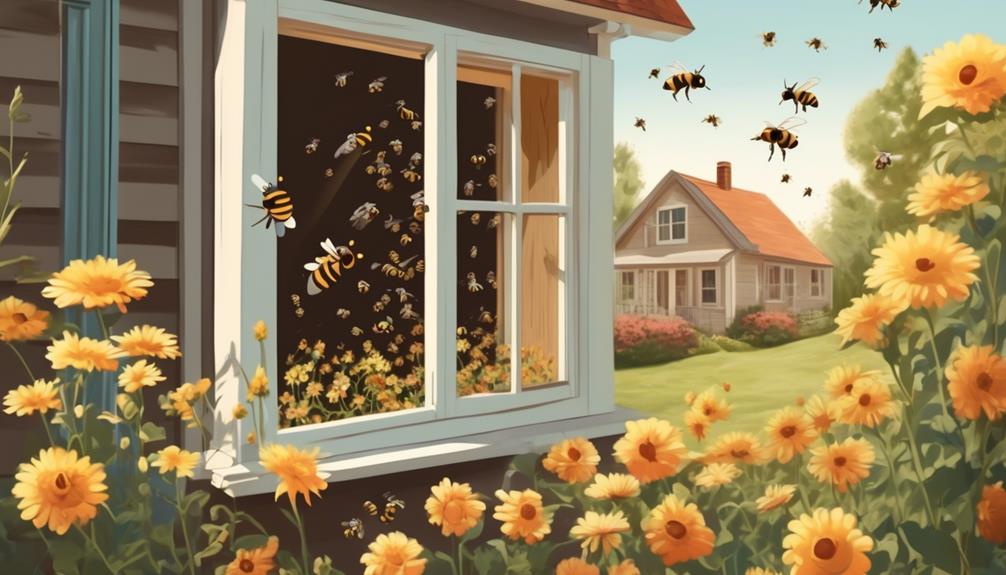
Why Are Bees Getting in My House?
'Well, isn't it just the bee's knees when you find your living room has become a popular hangout for bees? You've likely noticed this peculiar phenomenon and are wondering what's drawing these buzzing visitors into your home.
It may be a shock, but bees aren't interested in your tasteful interior design or your cozy ambiance. There are specific things in your home that are irresistibly attractive to them.
So, are you ready to discover what's turning your house into a bee magnet and how you can stop it? Let's dive into the buzz of the matter.'
Key Takeaways
- Bees are attracted to sugary substances, potential nesting sites, and certain scents.
- Common house entry points for bees include cracks, gaps, vents, and chimneys.
- Seasonal changes impact bee infestations, with spring being the peak season.
- Prevention strategies include sealing entry points, installing screens, and limiting flowering plants.
Understanding Bee Behavior
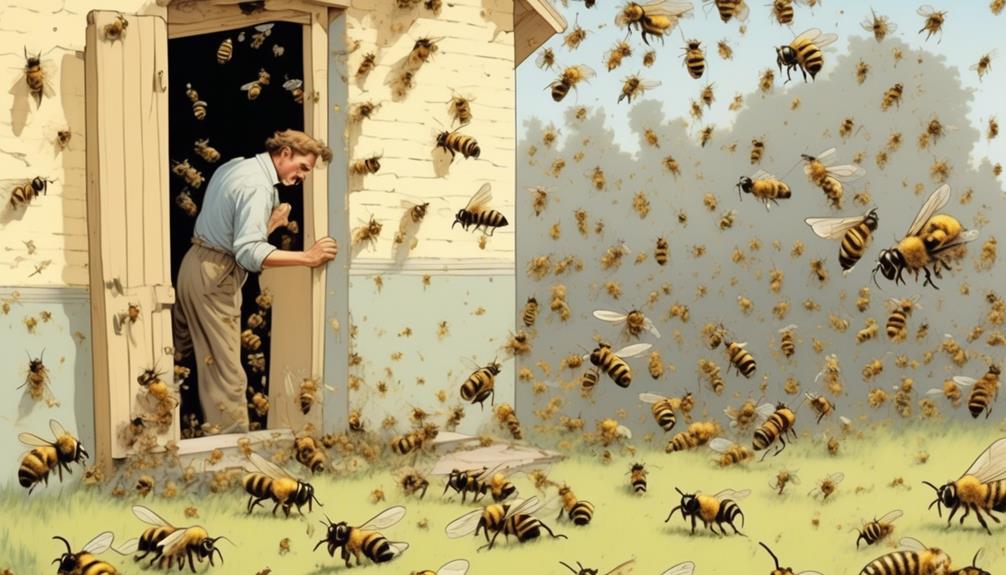
To effectively manage bees entering your house, it's crucial to understand their behavior, which is driven by factors such as their search for food, shelter, and nesting sites. Bees aren't typically invasive or aggressive; they're simply looking for resources to sustain their colony. The opportune conditions found in your home may be enticing them.
Nectar and pollen, the primary food sources for bees, are often found in gardens or nearby flowering plants. If you've noticed bees in your home, it's likely there's a food source attracting them. Keep an eye on your flowering plants, especially during blooming season.
Shelter and nesting sites are another significant aspect of bee behavior. Bees need safe, protected spaces for their hives. Cracks, walls, roofs, and chimneys often provide suitable spaces for bees to build their nests. Regularly checking these areas can prevent a full-blown infestation.
Lastly, remember that bees are highly social creatures. They follow scout bees to new locations, explaining why you might suddenly see a swarm. Understanding these behaviors can give you the upper hand in managing bees and keeping them out of your home.
What Attracts Bees Indoors
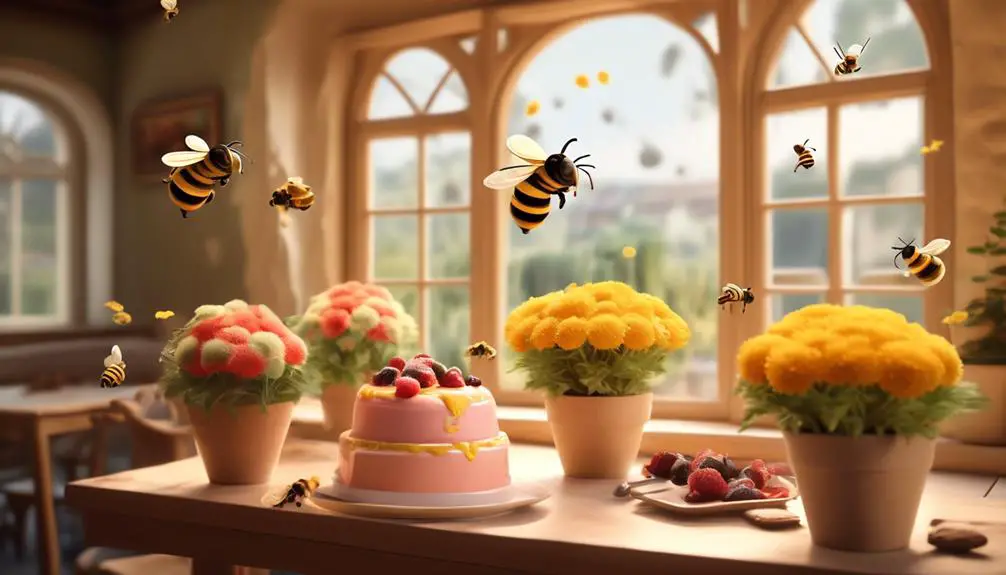
Unraveling the mystery of what lures bees into your home requires a close examination of the key attractants, namely the presence of food sources, potential nesting sites, and certain scents.
Bees are drawn to sugary substances and may find their way indoors if you've unwittingly left out items like open soda cans, fruit, or sweet residues.
Potential nesting sites, like wall cavities, chimneys, and roof eaves, are also strong attractants. Bees prefer dark, sheltered areas for their colonies, and your home's architecture might unwittingly provide the perfect spot. So, you'll need to keep a keen eye for potential nesting sites and seal them up promptly.
Lastly, certain scents can be irresistible to bees. Floral or sweet fragrances, such as those from perfumes, candles, and air fresheners, can also draw bees indoors. It's not just artificial scents, either. Natural scents from blooming indoor plants or fresh-cut flowers can also be enticing.
Understanding these factors is crucial in managing unwanted bee invasions. By minimizing these key attractants, you can significantly reduce the likelihood of bees buzzing into your home. Remember, prevention is always better than cure.
Common House Entry Points for Bees
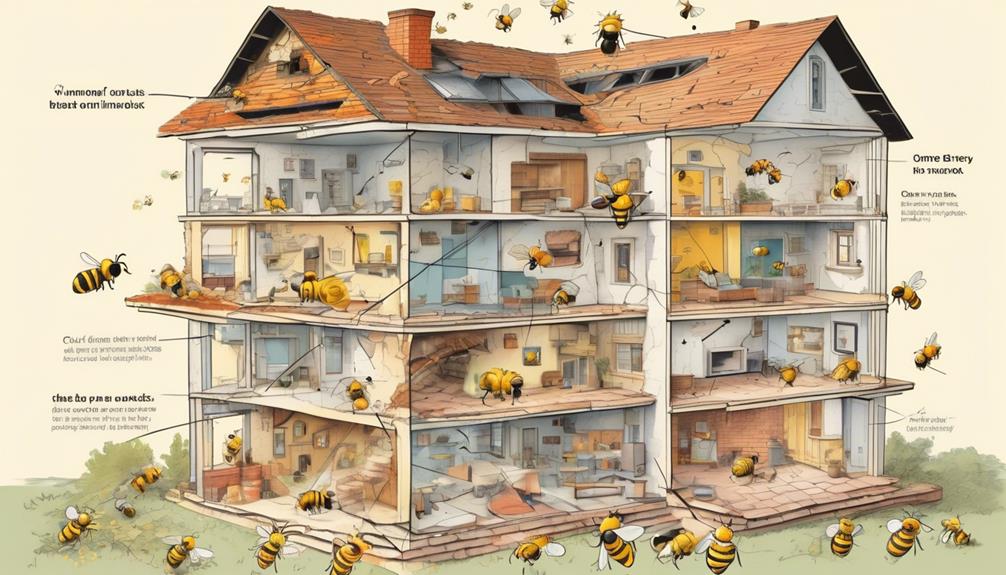
Your home's structural weaknesses may serve as gateways for bees, with common entry points including cracks in the walls, gaps around windows and doors, vents, chimneys, and even damaged foundations. When bees are scouting for a new hive location, they seek out small openings that lead to protected, secluded spaces.
Following a meticulous search, they may exploit these vulnerabilities, transforming them into entrances for their colonies. The bees' small size and agility enable them to navigate these spaces effortlessly. A crack that seems insignificant to you could be a perfect doorway for a bee.
Furthermore, bees may enter your house through vents, often drawn in by the warmth and shelter they provide. Chimneys too are a prime target for these insects as they mimic the hollow of trees, a natural habitat for many bee species. Damaged foundations, meanwhile, provide a ground-level access point that's especially attractive to bees preferring to nest near the ground, such as bumblebees.
Therefore, to prevent bees from entering your home, it's essential to seal these potential entry points and regularly inspect for signs of bee activity. Remember, early detection and intervention are key to keeping your home bee-free.
Impact of Seasonal Changes
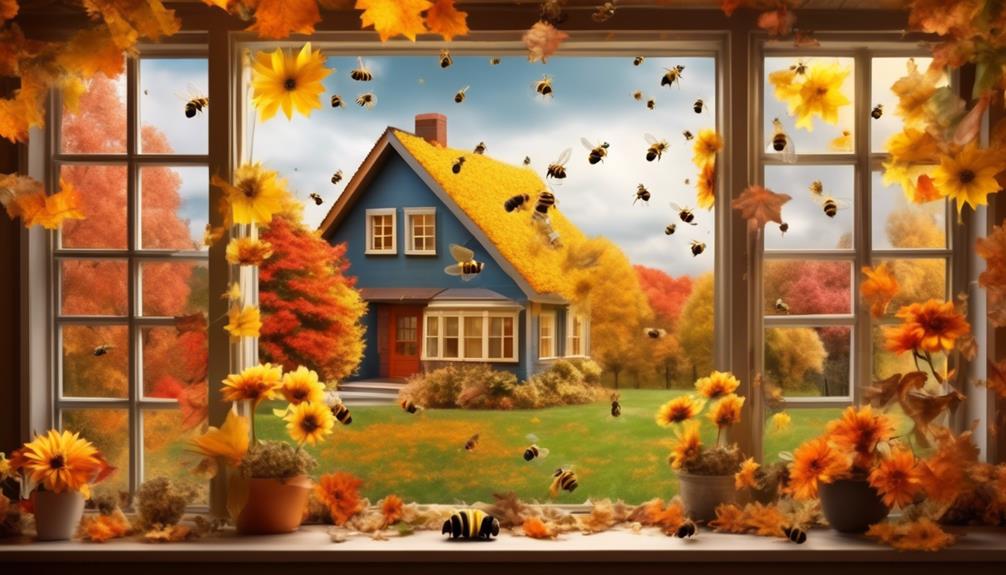
While addressing these structural vulnerabilities can significantly reduce the risk of bees entering your home, it's equally crucial to understand how seasonal changes can impact bee behavior and hive movements.
In spring, bees emerge from winter hibernation to start foraging and building their hives. They're on the lookout for new homes, so your house could become a potential nesting site, particularly if it presents easy access points. Spring is, therefore, a peak season for bee infestations in homes.
As summer rolls around, bees become more active, and their hives grow in size. The heat can also drive bees to seek cooler environments, such as your air-conditioned home. On the flip side, in autumn, bees prepare for the colder months by sealing their hives and storing food. This period sees a drop in bee infestations.
However, if you've had a bee problem in the spring or summer, don't assume it's resolved come winter. Bees may still be hibernating inside your home, ready to re-emerge when temperatures rise again.
Understanding these seasonal patterns can help you prepare for, and potentially prevent, unwanted bee invasions.
Prevention Strategies and Solutions
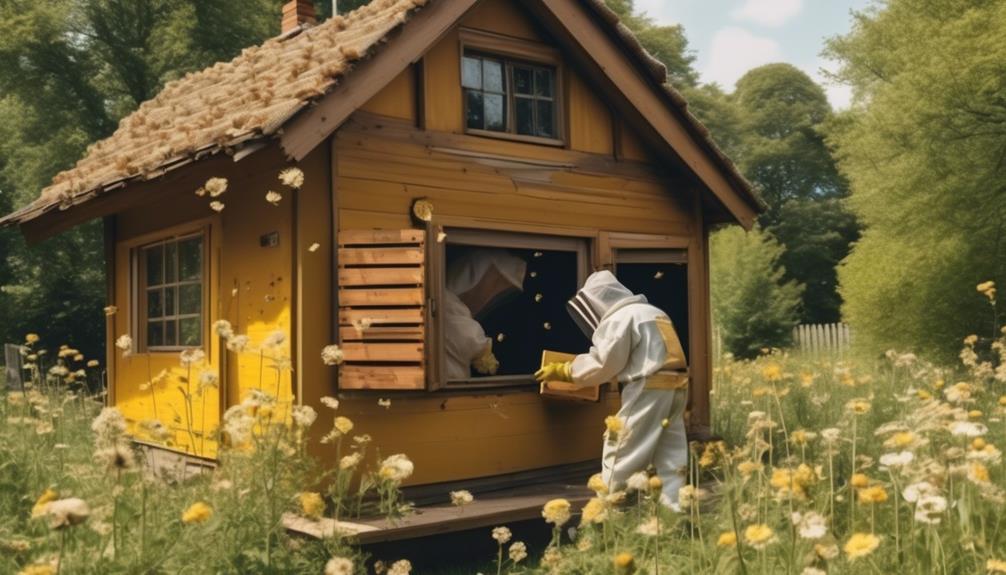
So, how can you safeguard your home against these industrious insects?
Firstly, seal off any potential entrance points. Bees are adept at exploiting tiny crevices and cracks in your home's exterior for nesting, so it's crucial you meticulously inspect your property. Use caulk or other sealants to close off gaps in windows, doors, and walls.
Additionally, consider installing screens over vents and other larger openings. This reduces the chance of bees gaining access while maintaining airflow in your home.
In your garden, avoid overuse of flowering plants. Bees are attracted to nectar-rich flora, so limiting these can help deter them. Additionally, regularly inspect outdoor areas for signs of bee activity, such as swarming or the presence of a hive.
Finally, if you're dealing with an established infestation, it's advisable to engage a pest control professional. They're equipped with the right knowledge and tools to safely remove the bees without causing harm to you or the bees themselves.
These preventative measures, when implemented correctly, can significantly reduce the likelihood of bees invading your home. However, remember that bees are beneficial to the environment, so aim to deter them from your home rather than eradicate them.
Frequently Asked Questions
What Types of Bees Are Most Likely to Invade Homes?
You're most likely dealing with honey bees or carpenter bees.
Honey bees often enter homes seeking a place to establish a new hive, especially in early spring.
Carpenter bees, on the other hand, burrow into wood structures, so they're attracted to wooden homes.
But it's not just the type of bee that's important, it's also about what's attracting them, like certain scents or flowering plants close to your home.
How Do I Safely Remove a Bee Hive From My House?
To safely remove a bee hive from your house, don't try to do it yourself. Bees can become aggressive when threatened. Instead, contact a professional bee removal service.
They'll have the necessary equipment and training to handle the situation safely. They'll also know how to relocate the hive without harming the bees, which is important because bees play a crucial role in our ecosystem.
What Are the Risks or Dangers Associated With a Bee Infestation in My Home?
You're facing several risks with a bee infestation in your home.
Firstly, there is the risk of getting stung, which is painful and potentially dangerous if you're allergic.
Secondly, bees can also cause damage to your property. They have the ability to burrow into wood and create hives in walls or roofs, which can lead to structural issues.
Additionally, having a bee infestation can attract other pests to your home, further exacerbating the problem.
Lastly, removing a hive safely and humanely is not an easy task and may require professional help. This can be a costly endeavor.
Can Bees Cause Structural Damage to My House?
Yes, bees can cause structural damage to your house. They're not just annoying pests. When they build hives in your walls, the weight can strain the structure. If you don't remove the hive, it'll attract other pests.
Plus, leftover honey can seep into your walls, causing further damage. It's important to address a bee infestation quickly to prevent these issues. It's not just about avoiding stings; it's about preserving your home's integrity.
Are There Natural Remedies to Deter Bees From Entering My Home?
Yes, there are natural remedies to deter bees.
You can plant bee repelling plants like mint, citronella, and marigolds around your house.
Another method is using essential oils. Bees dislike peppermint, tea tree, and citronella oils.
Mix a few drops with water in a spray bottle and spritz around windows and doors.
However, it's important to remember bees are beneficial insects, so consider creating a bee-friendly space away from your home instead.
Conclusion
In conclusion, it's your home's allure, such as lingering floral scents, and easy entry points that draw bees indoors. Seasonal changes also play a role.
But don't fret! By understanding bee behavior and what attracts these buzzing visitors, you can effectively seal common entry points and adjust your habits to make your home less inviting.
It's all about adopting smart prevention strategies to keep these industrious pollinators from becoming unwelcome houseguests.

